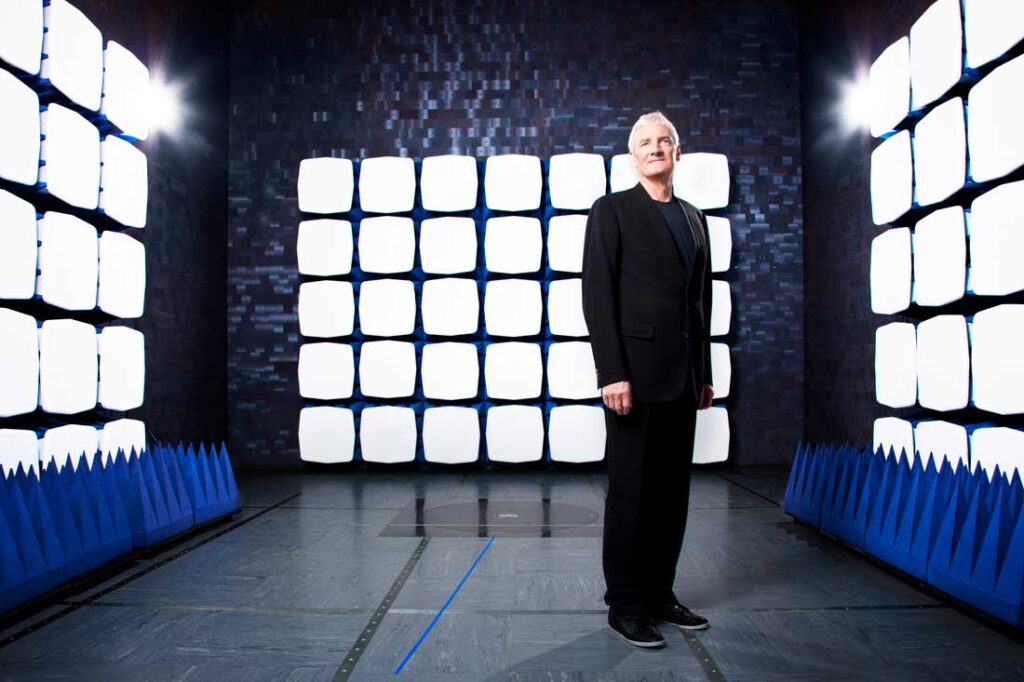Have you ever been annoyed by an everyday household glitch? Maybe the dishwasher doesn’t dry your plastics completely. Perhaps you’re tired of waiting the 20 seconds or so it takes your shower water to heat up. When that happens, do you get over it after a minute or two? Or do you spend the next 15 years of your life developing a foolproof dishwasher? Do you bring your family to the brink of bankruptcy riding on a dream of a more efficient water heater? If you’re James Dyson, that answer would be yes.
“As I have often said, I aim not to be clever, but to be dogged,” Dyson wrote in his autobiography, Against the Odds. Dyson is clever, for sure—spend 10 minutes with him and your head will spin as fast as one of his patented motors with explanations of turbines, positive and negative ions and particle emissions. But his doggedness is what made him and his clever vacuums household names.
James Dyson’s inspiration: solve an everyday problem
In 1978, while vacuuming his home in Bathford, England, he noticed that the bag in his Hoover upright quickly became clogged with dust and lost its suction. And with three kids younger than 8—which is to say, with lots of dirt and debris—this underperformance bugged Dyson. While you or I might accept a little dust as a fair price to pay for the convenience of a machine that sucks Cheerios and pet hair from rugs, Dyson did not. Instead, he devoted his life to developing and marketing a new vacuum technology.
Around the same time, Dyson was producing another of his inventions: the Ballbarrow, an ingeniously simple rejiggering of the wheelbarrow. With a ball instead of wheel, the barrow was easier to move and could turn on a dime.
The plant where the Ballbarrows were manufactured used a giant fan to catch and filter the errant epoxy paint used on the carts, but other factories—such as timber factories—used enormous cyclones to do the same. (Put simply, cyclonic separation technology rotates air through a cylinder at high speeds to extract any particles from it, in case you’re wondering.)
Though the Ballbarrows failed, Dyson had a new idea. At home, he fashioned a miniature cyclone out of cardboard and duct tape and attached it to his Hoover in place of the bag. His do-it-yourself project worked, and the first cyclonic bagless vacuum was born.
James Dyson’s 15 years of struggle
But the story is never as simple as its retelling. Between his taped-up prototype and the beginning of his current market prevalence, there were 15 years of rejections, lawsuits and near-bankruptcy, alongside thousands of prototype revisions. That’s where the doggedness—and a supportive wife—comes in. By Dyson’s side since they met at art school was Deirdre, an illustrator and graphic designer by training (she now custom-designs carpets). Deirdre supported Dyson’s prototype habit with her modest salary as an art teacher.
His autobiography (dedicated to Deirdre for being “stoic in the extreme” and for bringing up their three children “at many times on her own”) details the dozens of almost-deals with manufacturers, investors, vacuum titans and distributors from all over the world that went awry at the last minute.
“What I realized,” he told SUCCESS, “is companies weren’t interested in investing in new technology. They were too afraid.” Or they were too invested in existing technology, he says: A vacuum manufacturer whose revenue relies heavily on bag sales isn’t going to rush toward bagless technology.
Dyson experienced failure after failure, but he saw them as the failures of people and corporations that might have given him money or sold his product. They couldn’t see the potential. “It was a wonderful opportunity, all these rejections,” Dyson says in his soothing, everything-will-be-fine lilt. “I learned I would have to introduce the technology myself.”
What excites James Dyson
One thing is clear when you talk to Dyson: He considers himself an engineering lodestar. He evaluates people, cultures and entire countries on their ability to engineer a tangible thing and their willingness to embrace new technologies engineered by others. (The Japanese and Americans are refreshingly enthusiastic about technology, he believes, but he is disappointed by his fellow Englishmen, who are “negative” and “unambitious” when it comes to innovation.)
He believes the designers of breakthrough products should also market them. He believes designers, engineers and inventors should lead the business, rather than turning that crucial task over to marketers, accountants and lawyers (“businessmen,” Dyson scoffs). Ask him whether he considers himself a businessman, after leading his company to financial success, and Dyson responds with an emphatic, “No, not at all. I’m a designer and engineer and maker of products.”
When SUCCESS first met Dyson, it was early 2013 at the launch of his hybrid Airblade motion-activated hand-dryer and faucet. He politely answered questions about his startup years and tough business decisions (in 2002, he moved production of his machines from Malmesbury, a small town in England, to Malaysia; more on this later).
But once he’s asked to describe the new digital motor that powers the Airblade, Dyson moves to the edge of his seat, gestures animatedly and speaks for minutes at a time, earnestly explaining how fast and efficient his turbine can be. “The fastest motor [before ours] was 30,000 rotations per minute [RPM]. A jet engine goes 15,000 RPM. A Ferrari racecar goes 18,000 to 19,000 RPM. Ours goes 100,000 RPM!” he says—and goes on. At great, excited length. And it’s easy to see how Dyson inspires his global team of more than 14,000 employees.
Progress at last
Designers and engineers need more than inventions; they need money to launch their products. And after years of hitting the pavement with little luck, Dyson was in dangerously short supply of cash. An early break came from the design-loving Japanese, to whom Dyson licensed his technology.
The first iteration of the cyclonic vacuum for sale was a pink upright called the G-Force, launched in 1986. Its popularity in Japan sustained Dyson’s efforts. But it wasn’t until 1993 that his personal pièce de résistance, the Dual Cyclone, also known as the DC01, was marketed under his own name. By 1995, it was the top-selling vacuum in the U.K.
Life at the Dyson Research, Design and Development Center
But the title dearest to Sir Dyson (he was knighted in 2007) was still “engineer.” As chairman of his company—Dyson stepped down in 2010—he spent most of his time and energy cultivating the “young and bright” engineers who worked for him at the Dyson Research, Design and Development Center. He thought of himself as an “ancient tutor” to these crackerjacks.
James Dyson thinks engineers should build their ideas themselves
Dyson had a rule for the center’s research and development activities: No technicians allowed. The engineers had to bring their ideas to life themselves. “They all have to make and test their own prototypes, which allows them to see what works and what doesn’t. You don’t get that from looking at a prototype made by someone else or by looking at test results,” he says.
Although Dyson no longer made models himself, he spent most of his day “breaking the prototypes” of his engineers, challenging them to go further and spot problems before they happened. Were the engineers nervous when Dyson started looking over their shoulders? “I was at the start,” says Marcus Hartley, a former design manager at Dyson, who worked on the Airblade Tap. “But James has got such a charisma about him. And being an engineer, he understands you. It’s not like you’re talking to the head of a company. He’s just an engineer. You can bounce ideas off each other.”
Keeping things in-house
Another rule: Dyson wouldn’t sell his technology or go public. “He could make loads of money selling the technology,” Hartley says. Dyson was confident the money would come from selling the company’s own well-engineered products—from the iconic vacuums and bladeless fans to the newer Corrale™ straightener and Hot+Cool purifier. “I don’t want our engineers to adapt their technology for others, but to keep thinking of ways for us to utilize it,” he says.
Dyson didn’t want his engineers to worry about pleasing investors, either, which is why he stayed private. “I’m never tempted to do an IPO. I want myself and everyone to just concentrate on bringing out the next new products. I want to keep it simple and think long-term,” he says.
James Dyson is one of Britain’s biggest stories
Dyson’s mentoring extended beyond his own research and development department. He tried to get his entire country to move its focus away from trading and back to creating and making. In 2010, he wrote a report called “Ingenious Britain: Making the U.K. the leading high tech exporter in Europe.” He has complained widely about the lack of engineers in the U.K. And his advice has been regarded highly.
“Dyson is one of Britain’s biggest success stories, and Sir James Dyson knows better than any bureaucrat how you start a business, build it up and start selling to the world,” Former Prime Minister David Cameron has said. “And he’s put that knowledge into this blueprint for creating a generation of innovation and enterprise.” High praise from a high place.
But Dyson’s dedication to building the U.K.’s export economy is why his company’s decision to move manufacturing to Malaysia over two decades ago was so infuriating for many. “It was a very painful, difficult decision,” Dyson lamented. “My CEO at the time recommended it, and he was right. It was all we could do.” The company was advised that the British government would refuse its application for factory expansion and that it could not appeal. “We had to go somewhere.”
And he doesn’t stop tinkering
However, the ever-tinkering engineer in Dyson won’t admit to success. “There are always difficulties and problems to be solved right in front of me and that’s how I feel on a daily basis. I like failure,” he says. “I like having to try and try all the time. Some things take years to get right. One has a sort of frown and a furrow on one’s forehead all the time. Then when you’ve made it work, you don’t sit back and have a glass of champagne. You get on to the next thing.
“Maybe I need to see a psychiatrist, but I’ve decided that if you never feel satisfied, it’s probably a good thing.”
This article was published in November 2013 and has been updated. Photo by © Matthias Clamer/Corbis Outline





